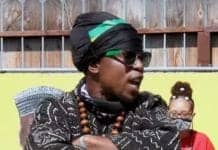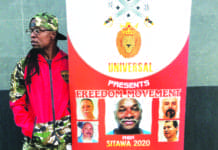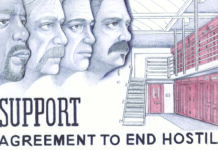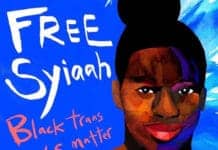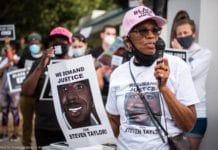by Antonio Guillen, Pelican Bay SHU Short Corridor Collective
I’ve been asked several times how it was possible that rivals from different racial and/or regional groups were able to see past differences and come together to form the Human Rights Movement. The Human Rights Movement is a concerted effort to end long term solitary confinement and make better the living conditions in all SHU and Ad Seg housing facilities across the state of California and the nation as a whole!
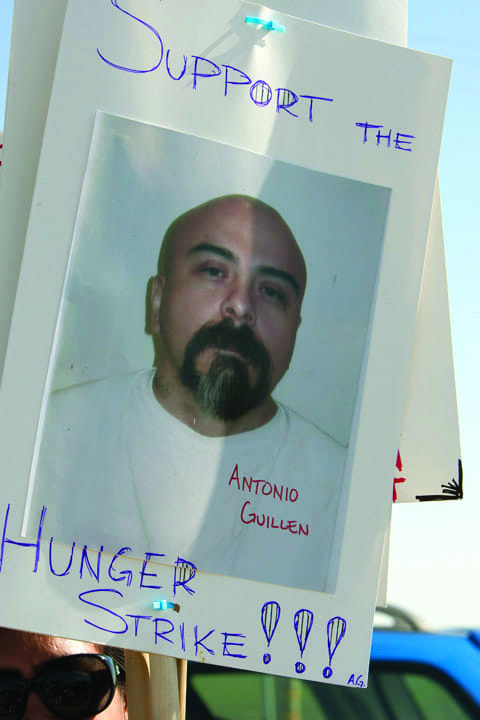
Now, before I share my venture I would like to take a moment to say that this Human Rights Movement has always been meant to be something positive, inspiring and groundbreaking for the betterment of all people on both sides of the wall. I did not expect such heated opposition – aside from CDCR – or the level of personal attacks on prisoner representatives and our outside support systems.
Our efforts and motivations have been demeaned, criticized and outrageously misconstrued. But, as I learned long ago, “If the powerful cannot meet you on the merits of your claims, then they will have no other option than to attack you on your person.”
My story
When I came to prison I was young and brought with me the attitudes and mindsets that were shaped and hardened by the years of gangbanging in the streets of San Jose and the several years spent in the California Youth Authority. Much like a blacksmith will pound his hammer repeatedly against an anvil to mold and shape a piece of iron into an object of symbol and strength, so too were my beliefs.
Once in the yard, in prison, I soon realized that life here at its core was no different from any other hostile environment I had experienced. And to survive I relied on the tenet I found to be true and have yet to fail me: Keep quiet, identify the danger and stand up when challenged.
Most of the traditional groups were separated by invisible boundaries that acted as territorial borders. Although there were those who maintained lines of communication between the groups for diplomatic reasons, there was no real and constructive interaction between the groups.
When I arrived to Administrative Segregation (Ad Seg) and then the Security Housing Unit (SHU), those same invisible boundaries between the groups existed, albeit in a different way due to the design of the Ad Seg and SHU facilities, but existed nonetheless. In fact, to some extent they appeared to be more prominent because of the anger, frustration and despair that modern day dungeons tend to induce within the human psyche.
Much like any other torture chamber, Pelican Bay State Prison (PBSP) SHU was designed to break the mind and spirit of those it had captured. The powers that be, which include the California Department of Corrections and Rehabilitation (CDCR), wanted nothing more than a docile and submissive creature to be pushed around and manipulated.
And unfortunately in most cases it did exactly that, causing a multitude to suffer new emotional and physical damages – the mentally ill to have their conditions exacerbated. And of course, let’s not forget those who were COERCED into taking part in the infamous debriefing program.
Much like any other torture chamber, Pelican Bay State Prison (PBSP) SHU was designed to break the mind and spirit of those it had captured.
In an effort to achieve the intended purposes of PBSP SHU, which is to create an environment that discourages a man’s ability and/or desire to socialize with other human beings, the powers that be took the following steps:
A) Modeled the design of PBSP SHU on out-of-state SHUs that divided each housing unit into six pods of eight men each;
B) Implemented local operations procedures that prohibit a prisoner from stopping at another prisoner’s cell to converse or pass items from one cell to the next (PBSP O.P.);
C) Utilized a CDCR regulation to prohibit a prisoner from conversing with another prisoner in a different pod (CCR Title 15, Section 3005 Conduct, Subsection (b) Obeying Orders);
D) Utilized practices used to maintain single cell occupation in order to reduce the head count per each pod, thus limiting the number of persons one has access to converse with, and;
E) Intentionally assigned rival prisoners from different races and/or regional groups to a pod. The idea being, if a pod were populated with those who didn’t socialize with each other to begin with, then this would further serve the intended purpose of discouraging their ability and/or desire to socialize.
Now let me be clear, when I speak on men’s ability and/or desire to socialize with other human beings, I am not referring to common tier courtesies such as letting your neighbor know whether or not you’re attending yard that day – just in case you pass on yard and his time slot gets pushed up. But rather I’m referring to one’s ability and/or desire to engage in deep, meaningful and stimulating conversation about similar interests – family, politics, sports, religion etc. – the sharing and debating of thoughts and ideas, and offering moral support in times of personal loss or tragedy. All of the things that make human beings, human beings.
In the beginning this approach worked surprisingly well, and to this day, many if not all of these policies and practices remain intact and in full effect. What the powers that be failed to realize, however, is that the mind and spirit of the human being can often times prove to be stronger and more resilient than concrete and steel. Several years after my arrival to PBSP SHU, I noticed that the attitudes and mindsets of many men who have long been a part of everyday life started to shift, including mine, in a monumental way!
Being enclosed in such a small environment – a pod of eight cells – where at any given time a man only has maybe seven other people in his immediate surroundings for many years, one cannot help but to get to know his neighbors. Whether this is motivated by survival instinct or because he is familiar with the next man from a different prison or if it is just basic human nature to reach out to another human being, I cannot say for sure. Maybe it’s a combination of all or something entirely different.
I’m referring to one’s ability and/or desire to engage in deep, meaningful and stimulating conversation about similar interests – family, politics, sports, religion etc. – the sharing and debating of thoughts and ideas, and offering moral support in times of personal loss or tragedy. All of the things that make human beings, human beings.
All I know is that, in spite of CDCR policy or procedure, people, regardless of their race, ideologies or regional background, gradually started to socialize with one another.
At first it seemed to start off with common tier courtesies, then to casual conversations which lead to more in depth discussions about a variety of topics. This allowed each of us to gain a better understanding of the next man – who he was, the things he cared about or believed in and his way of thinking. At least for me, I soon realized that many of these men were no different from who I am. We shared the same interests and things of importance, and some of us even thought along the same lines.
As time went by, we soon started to share reading materials – books, magazines, newspapers etc. – and providing legal assistance – filing prisoner grievances and court litigation. And for those men who didn’t have the means to purchase items from the prison commissary – writing materials, personal hygiene, food, beverages – the rest of the pod would get together and help out when we could.
This aid would also extend to yearly packages, and often men asked their families to send a package to someone in need. And, when we were able to several years ago, if one was fortunate enough to purchase a new appliance – TV or radio – he would often donate his old appliance to someone who didn’t have one.
Of course this didn’t work for everyone – there being some who are naturally reclusive and tend to keep to themselves and others whose suffering has affected them differently, possibly more severely than the rest of us, and have, by choice or otherwise, withdrawn from reality. But for those of us who were able and willing, we gradually came together in much the same way as a growing community would. We formed strong connections and understandings and looked out for each other.
Now this is not to say that everything has been sunshine and roses since then. There are still many negative forces that we routinely contend with – namely, those that have led to the evolution of these hunger strikes. It was, however, the courage and determination of the men who chose to stand up to the CDCR and challenge the torturous intent for PBSP SHU on all fronts – but specifically in the area of men’s ability and/or desire to socialize – that ultimately forged strong and respectful relationships between men of different races and regional backgrounds that in turn allowed many of us to come together and bring this Human Rights Movement!
I hope this has shed some light on the question at hand. But, more importantly, I hope that I was able to clearly communicate my thoughts and experience. Power to the people!
Antonio Guillen is one of four main hunger strike volunteer prisoner representatives. Send our brother some love and light: Antonio Guillen, P-81948, P.O. Box 7500, Crescent City CA 95532. This statement was written on Aug. 26, 2013, Day 50 of the hunger strike.

 Store
Store


